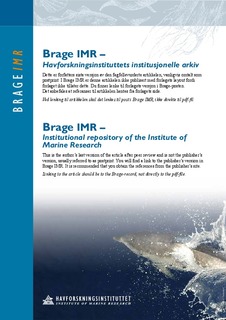| dc.contributor.author | Nilsson, Jonatan | |
| dc.contributor.author | Kristiansen, Tore S. | |
| dc.contributor.author | Fosseidengen, Jan Erik | |
| dc.contributor.author | Stien, Lars Helge | |
| dc.contributor.author | Fernö, Anders | |
| dc.contributor.author | van den Bos, Ruud | |
| dc.date.accessioned | 2010-12-20T08:13:44Z | |
| dc.date.available | 2010-12-20T08:13:44Z | |
| dc.date.issued | 2010-03 | |
| dc.identifier.issn | 0376-6357 | |
| dc.identifier.uri | http://hdl.handle.net/11250/117162 | |
| dc.description | Journal homepage: http://www.elsevier.com/wps/find/journaldescription.cws_home/506046/description#description | en_US |
| dc.description.abstract | We studied the learning capacities and anticipatory behaviour in a “sit-and-wait” predatory fish, the Atlantic halibut, Hippoglossus hippoglossus. In Experiment 1 two groups of halibut received series of light flashes (conditioned stimulus, CS) that started before delivery of food (unconditioned stimulus, US) and persisted until after food delivery, i.e. delay conditioning. Control groups received unpaired CS and US presentations. The anticipatory behaviour of delay conditioned halibut consisted mainly of take-offs towards the surface shortly after onset of the CS. In Experiment 2 six groups of halibut were trained in three trace conditioning procedures: Two groups with 20 s, two groups with 60 s and two groups with 120 s trace interval. Learning was evident in the 20 and 60 s trace groups and in one of the 120 s trace groups. In contrast to delay conditioning the anticipatory behaviour of trace conditioned halibut was characterized by subtle movements near the tank floor with orientation towards the CS. The cautious responses of halibut after trace conditioning differed markedly from what is observed in other fish species and are suggested to reflect a “sit-and-wait” foraging strategy that requires the predator to remain undetected until the prey is within lunging range. | en_US |
| dc.language.iso | eng | en_US |
| dc.publisher | Elsevier | en_US |
| dc.subject | halibut | en_US |
| dc.subject | kveite | en_US |
| dc.title | Learning and anticipatory behaviour in a “sit-and-wait” predator: the Atlantic halibut | en_US |
| dc.type | Journal article | en_US |
| dc.type | Peer reviewed | en_US |
| dc.subject.nsi | VDP::Agriculture and fishery disciplines: 900::Fisheries science: 920::Resource biology: 921 | en_US |
| dc.source.pagenumber | 257-266 | en_US |
| dc.source.volume | 83 | |
| dc.source.journal | Behavioural Processes | |
| dc.source.issue | 3 | |
| dc.identifier.doi | http://dx.doi.org/10.1016/j.beproc.2009.12.008 | |
